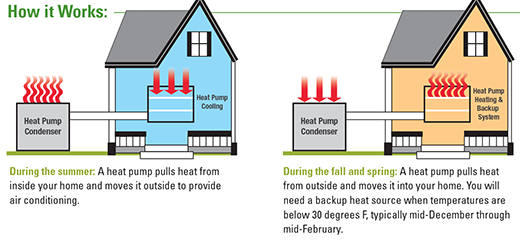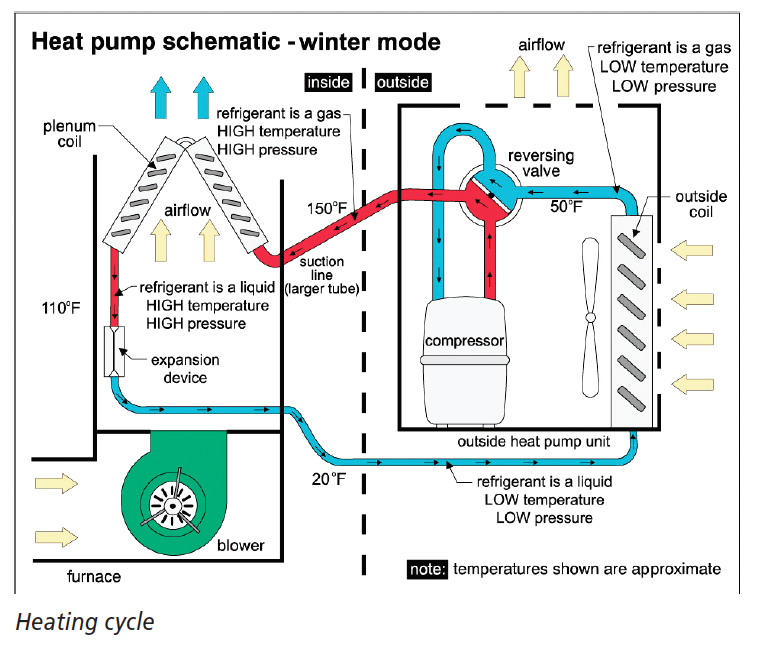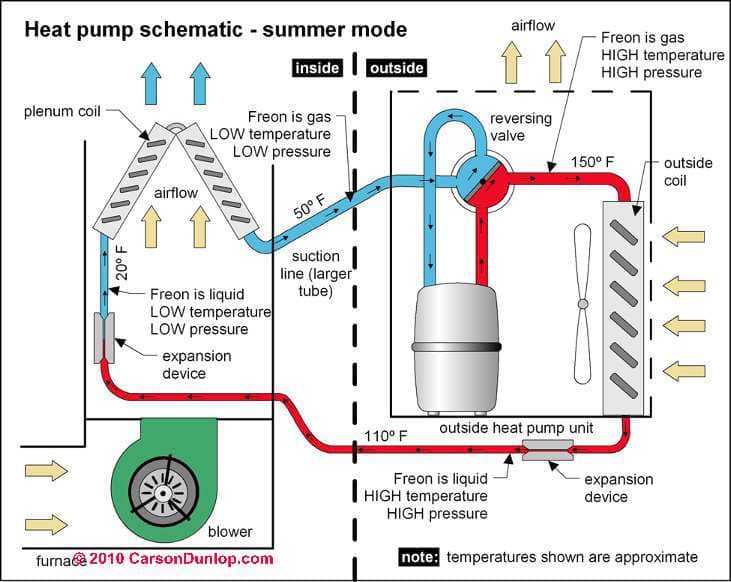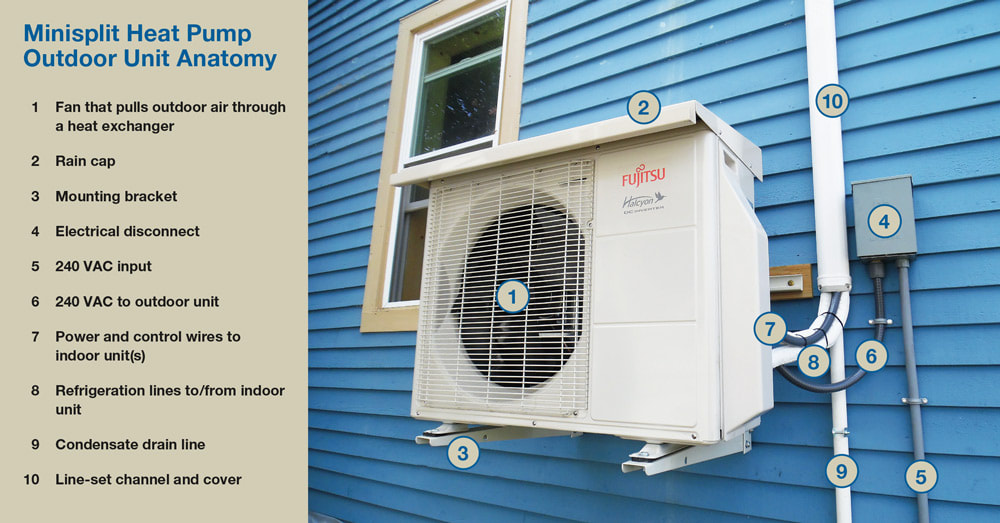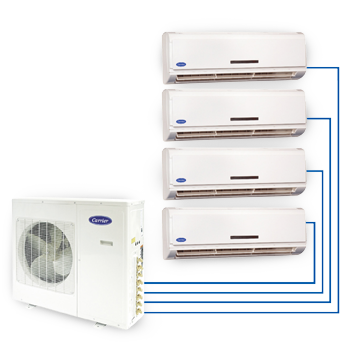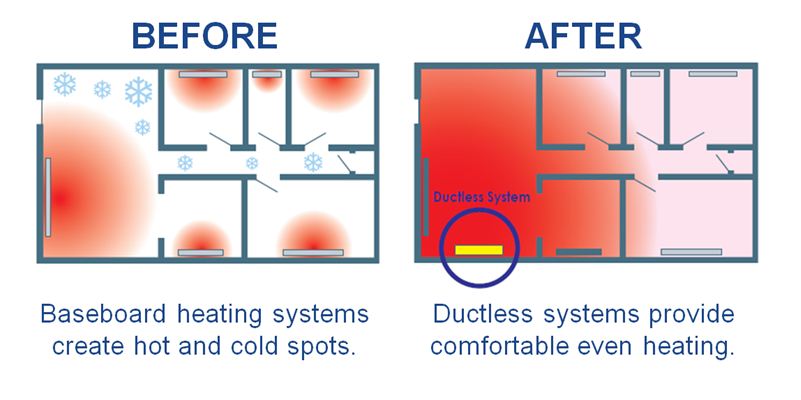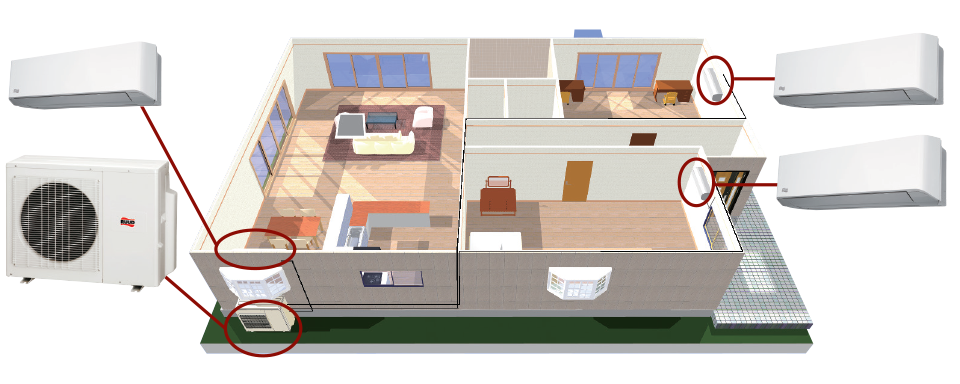|
|
THE BASICS
How do heat pumps work?
A heat pump is simply a device that transfers heat. It adapts the principles of the Second Law of Thermodynamics (heat moves from higher to lower temperature spaces) and the Ideal Gas Law (pressure of a gas is proportionate to its temperature). Thus, when you open your front door on a cold day, it feels like the cold is coming inside. In fact you're letting the heat out, and the absence of heat makes it feel cold (relative to your body's heat). And if you decompress a refrigerant in its vapor form, it will cool, and if you compress it, it will heat up which is the essence of a heat pump's cooling and heating cycle. These principles were well known in the early nineteenth century, and as a result the concept of a heat pump was developed in the 1850s, with modern versions put into use a hundred years later.
Heat pumps don't create heat - they just move it from one place to another. This is different from traditional furnaces that combust fuel, thereby generating heat for your home, or electric heat that generates heat by sending a current though a high resistance wire. So even when it's cool outside, there's still some heat in the air that the heat pump can grab onto. And likewise, in the summer, the heat pump can take the warmth in your home, even though it's cooler than outdoors, and remove it to the outside. It's understandable that the colder it is outside, the less heat there is for the heat pump to vaporize the refrigerant (the process is described below and in the videos to the left), and so heat pumps struggle to keep your house warm below certain critical temperatures (more on this later). There are three kinds of heat pumps: air-to-air, water source, and geothermal. They all work on the same principle, collecting heat from the source, be it air, water or in the ground, and bringing it into the house to act upon the heat pump system. This website will only focus on air-to-air heat pumps since they are reversible and can cool your home during the summer. We'll also focus ductless heat pumps, or so-called mini splits, because these are very popular in the Southern U.S. where homes need air-conditioning but lack ducts for central air. Heat pumps in fact are most popular in the South for cooling, and supplemental heat in the spring and fall; and only recently have been used in northern states for heating, due to improvements in technology. Looking at the winter heating cycle illustrated to the left, and in the videos provided, cold air is blown from outdoors into the heat pump where it is at low (i.e. ambient) temperature and pressure. It is blown onto the coils in which cool refrigerant is circulating. If there's enough heat in this ambient air, it may higher than the boiling point of the refrigerant liquid, which then vaporizes turning into a warm gas. This vapor enters the compressor which squeezes the gas, and (in accordance with the Ideal Gas Law) this gas becomes even hotter when compressed. The hot vapor is then sent to the indoor unit where it enters the coils of the indoor unit. A fan blows against this coil, blowing the heat into the home. The refrigerant then moves through an expansion device that reduces its pressure and temperature, where it is returned to the outside coil to be heated up by the incoming outdoor air again, and thus the cycle repeats. Of note here is that the warm refrigerant circulating in the coils of the indoor unit won't heat a room on its own. It must be blown by the fan into the home. This blowing heat (a) will only gradually heat the space, and (b) will feel cool if blowing directly on you (the heat is typically less than body temperature, and thus will feel cool). Heat pumps typically just heat the room they are installed in since heat is only propagated by the fan in the indoor unit. This heat will gradually heat other rooms over time, which is why multiple indoor units are needed for multi-room homes. Also, as explained in the video to the left, a heat pump acts as a kind of dehumidifier and produces a very dry heat. Moisture drips off the outdoor end of the compressor, which if the temperature is near freezing, will result in ice buildup on the outdoor compressor, blocking the air flow and causing the heat pump to fail. As a result, all heat pumps need to go through periodic defrost cycles. Defrosting means the heat pump switches for several minutes from heat mode to cooling mode, sending hot refrigerant across the outdoor compressor coil, melting the ice. Needless to say, this will result in periods of no heat for the home. The defrost cycle is illustrated in the first video to the left. Note: while various brands of equipment are pictured or described in this article,these are for illustrative purposes only, and this site does not recommend, sell, advertise or endorse any brand of heat pumps.
The equipment
Heat pumps don't generate heat, as explained above, but move it from place to place using various pieces of equipment. It is basically a mechanical-compression cycle refrigeration system consisting of an outdoor unit , indoor unit, refrigerant, compressor, reversing valve, and expansion valve.
The outdoor unit contains a coil and fan. The coil acts as either a condenser (in cooling mode) or an evaporator (in heating mode). The fan blows the outside air over the coil to make the heat exchange possible. The indoor unit is the air handler and also contains a coil that acts as an evaporator (in cooling mode) or as a condenser (in heating mode), and a fan that's pushes the air across the coil and into the rooms of the home. The refrigerant is a liquid that absorbs and rejects heat as it circulates throughout the heat pump system. It has a low boiling point which allows the ambient heat from the environment (from outdoors in the winter or indoors in the summer) to convert the liquid refrigerant into a hotter gas vapor. The compressor pressurizes the vapor refrigerant, thereby heating it up further, and moves it though the system. The reversing valve reverses the flow of refrigerant, allowing the system to switch between heating and cooling. The expansion device acts as a metering device, regulating the flow of the refrigerant as it passes through the heat pump, changing the pressure and temperature of the refrigerant. These parts are illustrated in the diagrams to the left and in the videos. Pictured at the top of this site is a model bedroom with an inside heat pump unit above the window. Other photos to the left show a typical installation of an outdoor unit (a Fujitsu unit) with electrical and refrigerant lines shown. Note that the outdoor unit has to installed above ground - in this case we see a wall-mounted unit. Common practice is also to set the unit on a concrete slab. This also protects the unit from snow buildup. The outdoor unit has to be installed away from all vegetation, since leaves and branches can either clog the air intake, or even get sucked in, causing the unit to fail. During winter, the outdoor unit must also be cleared of any snow or ice buildup,. The next photo shows a carrier outdoor unit connected to four indoor units. Since the indoor unit typically only heats a single room at a time (maybe 2 rooms over a long period of time), these four indoor units shown will typically only heat 5 rooms. More on zoning below. Heating zones
Heat pumps, as we learned above, distribute heat to a room by blowing air across a heated coil. Just as when you blow on hot food or coffee, your breath will absorb some the heat and cool down the food or drink, and then that blown air will cool down itself as it travels further from the heat source. The strength of the fan will determine are far the air is blown into the room. Typically air blown from a heat pump will feel cool to you since even if it's at 90 degrees F, it's still cooler than body temperature.
The Before and After diagram to the left compares electric baseboard heating to that of a heat pump. Baseboards don't have any fans to push the heat from the baseboard, so a room is heated just as the heat naturally seeps into the room (as we saw above, heat moves "downhill" from warmer to colder spaces). In the case of a heat pump, the fan pushes the heat away from the heat source, and so will gradually heat more than one room, depending on the configuration of the rooms. It takes time, maybe hours, to heat more than one room since the heated air loses heat the moment it leaves the heat pump indoor unit. As mentioned, the fan itself doesn't push the heat more than five feet out from the heat pump, and so other rooms will only gradually be heated as the warmth seeps into those rooms over time. So a multi-room home will need multiple indoor units to heat several homes. The second diagram to the left shows three indoor units used to heat three rooms in a house. The video to the left shows what the heat pump units look like, installed in a home. In this case there are five zones and five indoor units, in addition to the outdoor unit and conduits for the refrigerant along the outside of the walls. This video also makes note of the noise produced by a heat pump. Because of moving parts (especially from the compressors and fans), both the outdoor and indoor units will produce noise, the larger the unit the more the sound. The third video to the left in this section shows the noise produced by a Fujitsu indoor heat pump placed in a bedroom. Noise According to Furnace Compare, here are some decibel (DB) ratings of some heat pumps. To give you an idea of common decibel levels, 30 DB is like the sound level of a whisper; 40 DB is the level of sound in a library; 50 DB is that of a running stream; 60 DB that of normal conversation; 70 DB is the noise level of a vacuum cleaner. 76 DB: Coleman LX 75 DB: Trane XR15 72-75 DB: Goodman DSZC18 72 DB: Amana ASZ16 69 DB: York LX 69 DB: Coleman Echelon 69 DB: Comfortmaker Performance 68 DB: York Affinity 58 DB: Lennox XP25 These are just the units rated by Furnace Compare, and are likely the outdoor component of a heat pump (though that's not clear). Commercially available heat pumps typically fall in the range of 40 - 60 DB for indoor units, and Mitsubishi claims that two of its brands come in at 19 DB, though this has been disputed by Fujitsu here. The issue here is that the Mitsubishi indoor unit runs at several levels, from low to high. Thus, one of its MSZ units is rated at 21 DB when running low, but at 41 DB when running high, which is comparable to one of Fujitsu's ASU units, which runs at 43 DB indoors, and which is likely what you're hearing in the video to the left. That's the indoor units. Outdoor units all typically run louder. The same outdoor units described here for Mitsubishi and Fujitsu both run at 49 DB, for example. |
